Genome-Wide Screening of the MYB Genes in Coptis chinensis and Their Roles in Growth, Development, and Heavy Metal Resistance
- PMID: 40428298
- PMCID: PMC12111318
- DOI: 10.3390/genes16050476
Genome-Wide Screening of the MYB Genes in Coptis chinensis and Their Roles in Growth, Development, and Heavy Metal Resistance
Abstract
Background:Coptis chinensis is a traditional medicinal plant rich in bioactive compounds like berberine, known for its antibacterial, anti-inflammatory, and antioxidant properties. This study aims to analyze the MYB transcription factor family in C. chinensis to better understand their roles in plant growth, development, metabolism, and stress responses. Methods: We employed bioinformatics to conduct a genome-wide identification of MYB genes in C. chinensis, followed by analyses of physicochemical properties, phylogenetic relationships, gene structures, chromosomal localization, conserved motifs, cis-acting elements, and expression patterns. Results were validated using qRT-PCR. Results: A total of 129 CcMYB genes were identified across nine chromosomes. Phylogenetic analysis categorized these genes into 19 subgroups, notably highlighting the S6 subgroup, which lacks counterparts in Arabidopsis. Comparative genomics revealed segmental duplication among gene pairs. Transcriptomic analysis indicated that CcMYB21, CcMYB40, CcMYB105, and CcMYB116 had high expression levels in stems. Importantly, CcMYB94 expression significantly increased under cadmium stress, suggesting its role in stress regulation. Conclusions: This study offers a comprehensive analysis of the MYB gene family in C. chinensis, underscoring the significance of MYB transcription factors in enhancing the plant's medicinal value and stress tolerance, particularly against cadmium exposure. These insights pave the way for further exploration of specific MYB genes to improve stress resilience in C. chinensis.
Keywords: CcMYB; Coptis chinensis; biosynthesis; cadmium stress; genome-wide identification; qRT-PCR.
Conflict of interest statement
The authors declare no conflicts of interest.
Figures


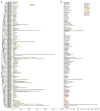
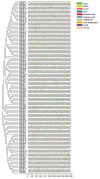
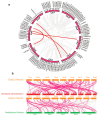
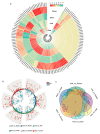
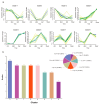
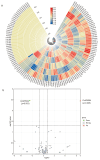

Similar articles
-
Genome-wide identification of AP2/ERF gene family in Coptis Chinensis Franch reveals its role in tissue-specific accumulation of benzylisoquinoline alkaloids.BMC Genomics. 2024 Oct 16;25(1):972. doi: 10.1186/s12864-024-10883-1. BMC Genomics. 2024. PMID: 39415101 Free PMC article.
-
Characteristics and Expression Analysis of the MYB-Related Subfamily Gene in Rosa chinensis.Int J Mol Sci. 2024 Nov 29;25(23):12854. doi: 10.3390/ijms252312854. Int J Mol Sci. 2024. PMID: 39684565 Free PMC article.
-
Genome-Wide Analysis and Expression Profiles of the MYB Genes in Brachypodium distachyon.Plant Cell Physiol. 2017 Oct 1;58(10):1777-1788. doi: 10.1093/pcp/pcx115. Plant Cell Physiol. 2017. PMID: 29016897
-
Genome-Wide Identification and Expression Analysis of MYB Transcription Factor Family in Response to Various Abiotic Stresses in Coconut (Cocos nucifera L.).Int J Mol Sci. 2024 Sep 18;25(18):10048. doi: 10.3390/ijms251810048. Int J Mol Sci. 2024. PMID: 39337532 Free PMC article.
-
Genome-wide identification of R2R3-MYB transcription factors in Betula platyphylla and functional analysis of BpMYB95 in salt tolerance.Int J Biol Macromol. 2024 Nov;279(Pt 2):135193. doi: 10.1016/j.ijbiomac.2024.135193. Epub 2024 Aug 30. Int J Biol Macromol. 2024. PMID: 39216584
References
-
- Yang Y., Vong C.T., Zeng S., Gao C., Chen Z., Fu C., Wang S., Zou L., Wang A., Wang Y. Tracking evidences of Coptis chinensis for the treatment of inflammatory bowel disease from pharmacological, pharmacokinetic to clinical studies. J. Ethnopharmacol. 2021;268:113573. doi: 10.1016/j.jep.2020.113573. - DOI - PubMed
MeSH terms
Substances
Grants and funding
LinkOut - more resources
Full Text Sources

